Tasty, juicy filling with soft, fluffy wrappers, homemade bao buns are super comforting! This guide offers tips and tricks to ensure a fail-proof cooking experience.
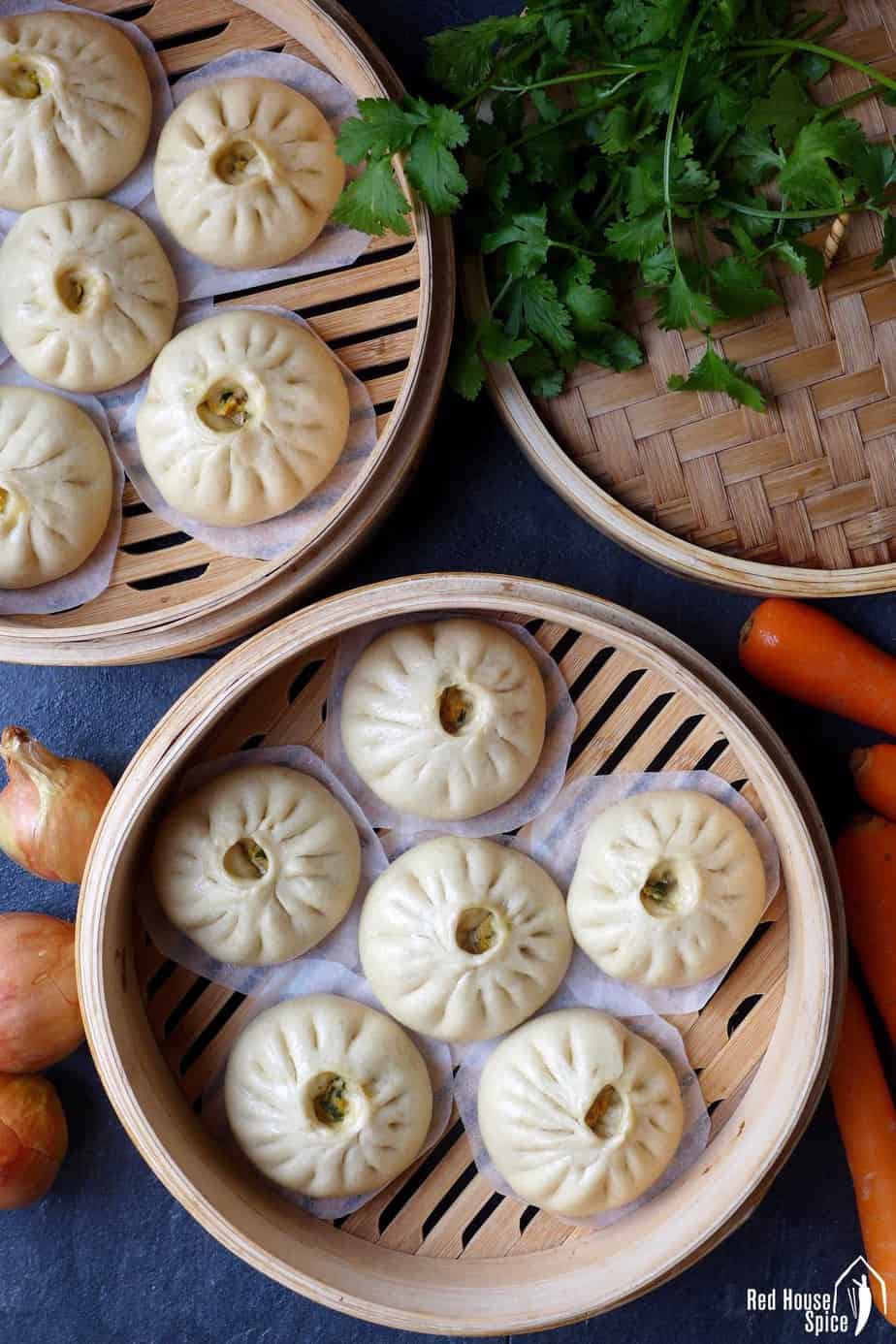
Popular as street food and an everyday family dish in China, steamed bao buns (Baozi, 包子) is one of the foods I really enjoy cooking. They are not difficult to make but it can be very tricky to get them right, especially when it comes to making a nice wrapper which rises properly, has a smooth look and a soft, fluffy texture. Today, I’m sharing all the knowledge I’ve gained through trial and error over the years.
Which type of flour for bao buns?
Which type of flour shall I use to make bao buns? My answer to this FAQ is all types of wheat flour works (regardless of the gluten level). However, you may wish to choose a particular type of flour to achieve a certain look/texture.
Do you like them fluffy and less chewy? Then use flour which has a medium to low gluten level. Check the nutrition label on your flour package. The protein content should be under 11g per 100g flour. As far as I know, common all-purpose flour in the UK and the US is within this range. It’s the type I use most frequently for bao buns.
Cake flour has 8-9g protein in 100g flour, so it delivers the least chewy texture. If like me, you don’t have easy access to cake flour, there is a simple substitute: Mix all-purpose flour with cornstarch (ratio: 5:1 by weight). Sift before using.
Another note: as yeast is used as a raising agent in bao buns, do not use self-raising cake flour which is commonly available in the UK.
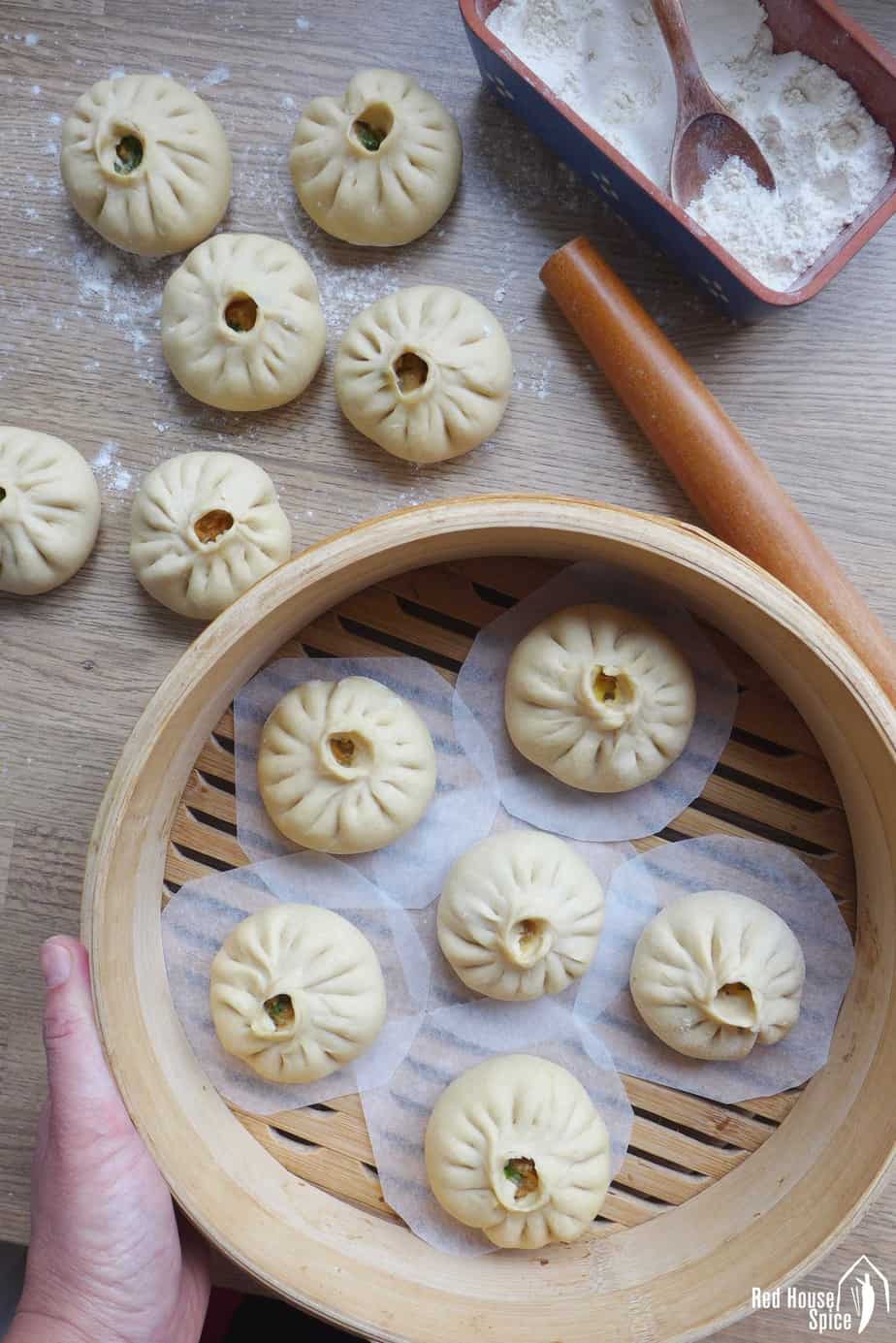
Is special bao flour better?
Flour specifically labeled as Bao bun flour/Mantou flour is available in Chinese/Asian shops. It has a low gluten level (around 8g protein in 100g flour) so it’s good for producing fluffy Bao. However, personally I don’t like it as it’s heavily bleached and processed (that’s why it produces a whiter finished look). I’ve tried several brands of bao flour and I find them lacking in natural wheat flavour.
How to make the dough?
Unlike dumpling (Jiaozi) dough which is made from water and flour, bao buns call for the leavened dough which involves the use of yeast. The wrapper rises during the process of steaming.
My recipe for Bao bun dough requires five ingredients: all-purpose flour; dried yeast; sugar; cooking oil, and lukewarm water.
- The flour & liquid (water + oil) ratio is 2:1 by weight. It may vary a little depending on the type and the brand of your flour.
- The water & oil ratio is 10:1 by weight. It’s better to choose the cooking oil which doesn’t have a strong taste (eg. rapeseeds, sunflower, canola, vegetable, etc.).
- For every 500g of flour, you will need 2 teaspoons of dried yeast. Add the same amount of sugar or a little less (but not more).
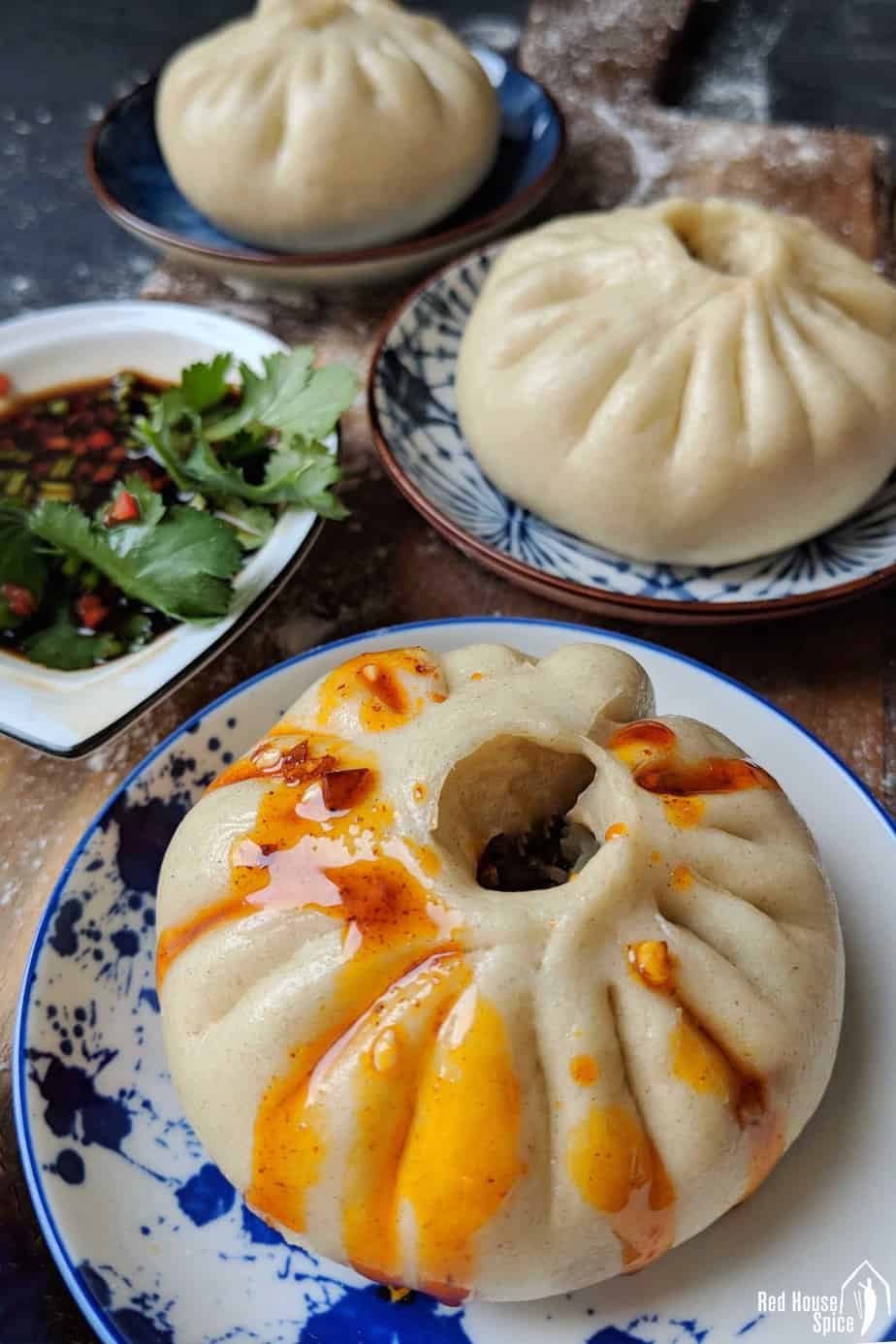
Why is kneading important?
Everyone loves a bao bun with smooth, even skin. Unfortunately, homemade ones can easily end up with a pot-marked look. The well-kneaded dough will create even air bubbles inside the dough and therefore lead to a smoother appearance after steaming.
I’ve done a test with my six-year-old daughter. We kneaded two identical pieces of dough then rested and steamed them in the exact same way. Obviously she has much less strength and skill in kneading. So her buns had a much rougher look. Another surprising finding was that extended kneading will lighten the colour of your dough.
Here are my tips on kneading:
- You may use your hands or a stand mixer with a dough hook. Knead until the dough is very smooth.
- For me, the best practice is to initially combine the dough in the stand mixer for 5 minutes or so, then knead with hands to finish.
- After the dough has risen and before shaping the buns, you need to knead the dough again until it returns to its original size and the smooth look.
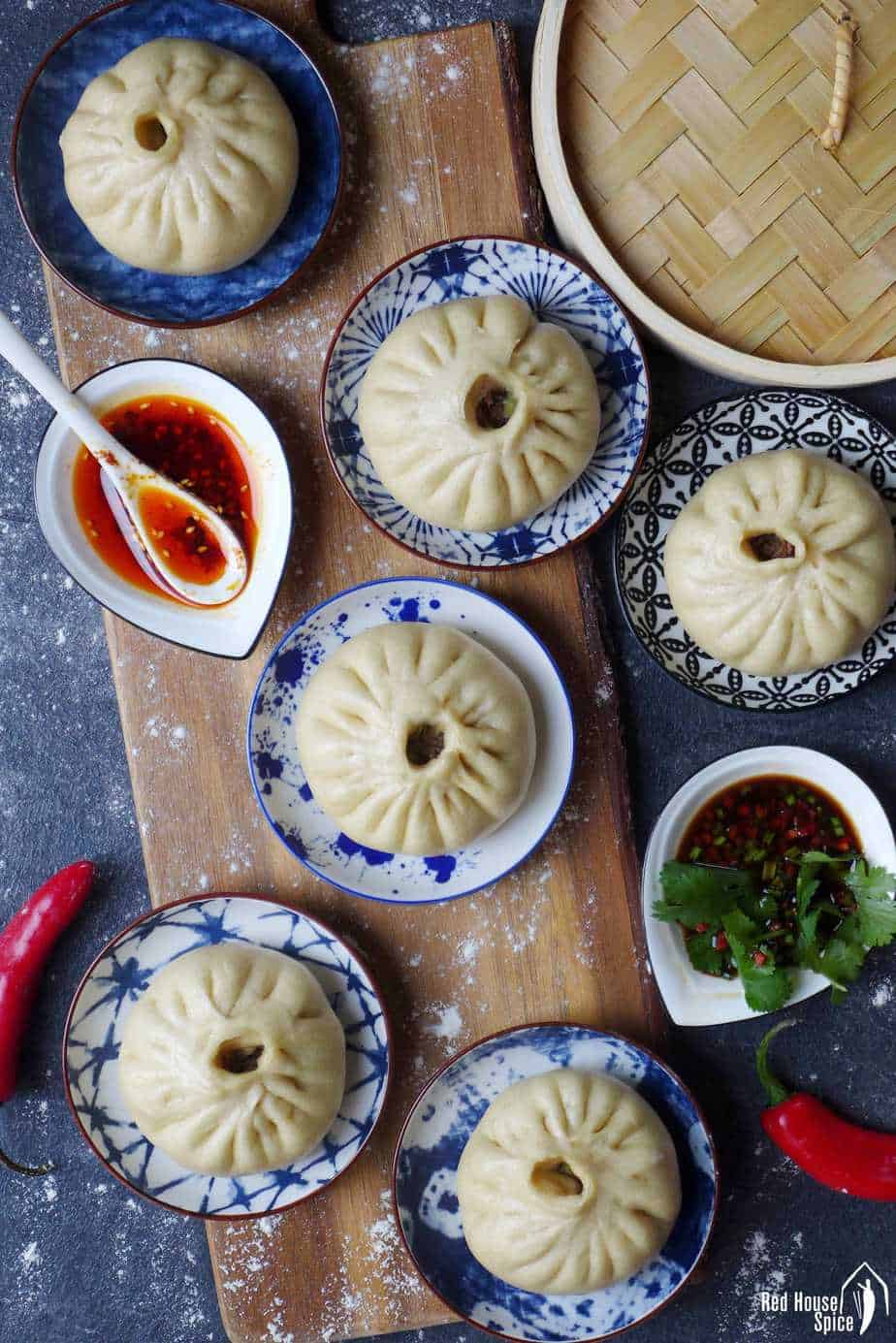
How long to rest the dough?
Fermentation takes place when you leave your yeast dough to rest. As yeast is very sensitive to temperature, the required resting time varies a lot. To double the size of the dough, it can take as little as 40 minutes if the room temperature is high (and/or if the dough is small in size), or up to 1.5 hours if it’s cold.
To accelerate this process, you can:
- Place the dough bowl in a warm room/area. For example, near a radiator or a preheated oven.
- Heat up a glass of water in the microwave then put your dough bowl inside (keep the glass in). Shut the microwave door.
- Turn on your empty drier for 2 minutes then place the dough bowl inside (I learned this trick from food blogger Nagi).
- Cover your bowl with a damp cloth as humidity also affects fermentation.
Leave the dough to rise until its size doubles. Then knead again to remove any bubbles trapped inside. After shaping the dough into individual Bao, leave them to rise a second time before steaming, about 15 minutes this time.
How to avoid bao bun collapsing?
If you have tried to cook bao buns before, you probably know how tricky it can be. The most common problem is that the wrappers collapse/wrinkle/harden after steaming. I believe many of you would hold your breath (or cross your finger) the moment you remove the steamer lid.
The inconsistency of the cooked wrappers used to drive me mad too. So I’ve conducted numerous trials and kitchen experiments to overcome these problems. Now I’m happy to share my findings with you.
- First of all, allow me to clarify a myth. Many recipes suggest that you should wait for 5 minutes before you uncover the steamer. This does not prevent collapsing at all. I always immediately remove the lid after I turn off the heat (as my parents and restaurant chefs do), my bao buns don’t change their look if the dough has been prepared properly.
- Make sure you include a little sugar and cooking oil when making the dough. Sugar helps to activate the yeast, therefore, guarantee a good rise. Oil reduces the transmission of the moisture from the filling into the dough, therefore make collapsing less likely.
- As I mentioned above, kneading affects the appearance of bao buns. Extend the kneading time and make sure the dough is perfectly smooth before shaping.
- It’s CRUCIAL to allow enough resting time during the dough fermentation process (two times as I explained above).
- Don’t roll your wrapper too thin (especially the middle part) otherwise the moisture from the filling might leak into the wrapper making it soggy.
- Start cooking with cold water in your steamer. The gentle rise in temperature helps the dough grow smoothly. Turn the heat down when water starts boiling. Count cooking time from this moment. I suggest no less than 15 minutes.
Make a tasty and juicy filling
I use pork and carrots as the main ingredients in this recipe. Onion and coriander are added to boost the flavour.
- Add water/stock to the pork will produce a juicy filling. You can find more tips on this topic in my post “How to make great dumpling fillings”.
- Briefly stir fry carrot and onion in a little oil. This will enhance their flavour and give the filling a soft texture.
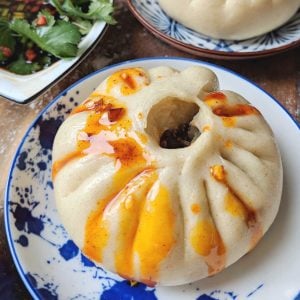
Steamed bao buns (包子), a complete guide
Ingredients
For the dough
- 300 g all-purpose flour - or cake flour, see note 1
- 1 teaspoon dried yeast
- 1 teaspoon sugar
- 1 tablespoon cooking oil - see note 2
- 140 ml lukewarm water - see note 3
For the filling
- 150 g minced pork
- 1 teaspoon light soy sauce
- 1 teaspoon oyster sauce
- 1 pinch ground Sichuan pepper - or Chinese five-spice powder
- ¼ teaspoon salt
- 4 tablespoon water - or unsalted stock
- 1 tablespoon cooking oil
- 150 g carrot - grated
- 1 small onion - finely chopped
- 2 tablespoon coriander - finely chopped
Instructions
Prepare the dough
- Mix flour, yeast, sugar and oil in a bowl. Pour in water little by little while mixing.
- Combine and knead with your hands until a very smooth dough forms (see note 4).
- Cover the bowl with a damp tea towel and leave to rise in a warm place until doubled in size (It will take between 40 minutes to 1.5 hours depending on the room temperature).
Mix the filling
- Put pork, soy sauce, oyster sauce, salt and Sichuan pepper/Chinese five-spice in a mixing bowl.
- Swirl constantly while gradually adding water/stock until no more liquid can be seen.
- Brief stir fry grated carrot and onion in oil until softened. Add to the pork along with chopped coriander.
Shape the buns (Please refer to the video below)
- Knead the dough until it goes back to its original size.
- Divide it into 12 equal portions. Roll each piece into a disk-like wrapper.
- Place some filling in the middle of a wrapper then fold into a bao shape.
- Leave all the assembled buns to rest for another 15 minutes or so.
Steam the buns
- Place the buns (with parchment paper underneath each one) in the steamer basket (see note 5). Leave 2cm space between the buns and the side of the steamer.
- Start cooking with cold water over a high heat. Turn the heat down to medium-low when the water starts boiling.
- Cook for 15-18 minutes.
Serving with a dipping sauce
- Serve them warm, on their own or with some dipping sauce (find inspirations in my post Six dumpling sauces).
Storage & reheat
- You can freeze cooked buns. Leave to defrost in the fridge then steam for 8 minutes to warm up, or steam for 15 minutes without defrosting.
Video
NOTES
NUTRITION
NUTRITION DISCLOSURE: Nutritional information on this website is provided as a courtesy to readers. It should be considered estimates. Please use your own brand nutritional values or your preferred nutrition calculator to double check against our estimates.


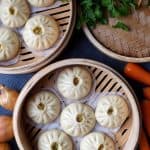
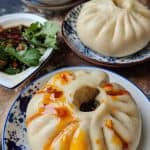
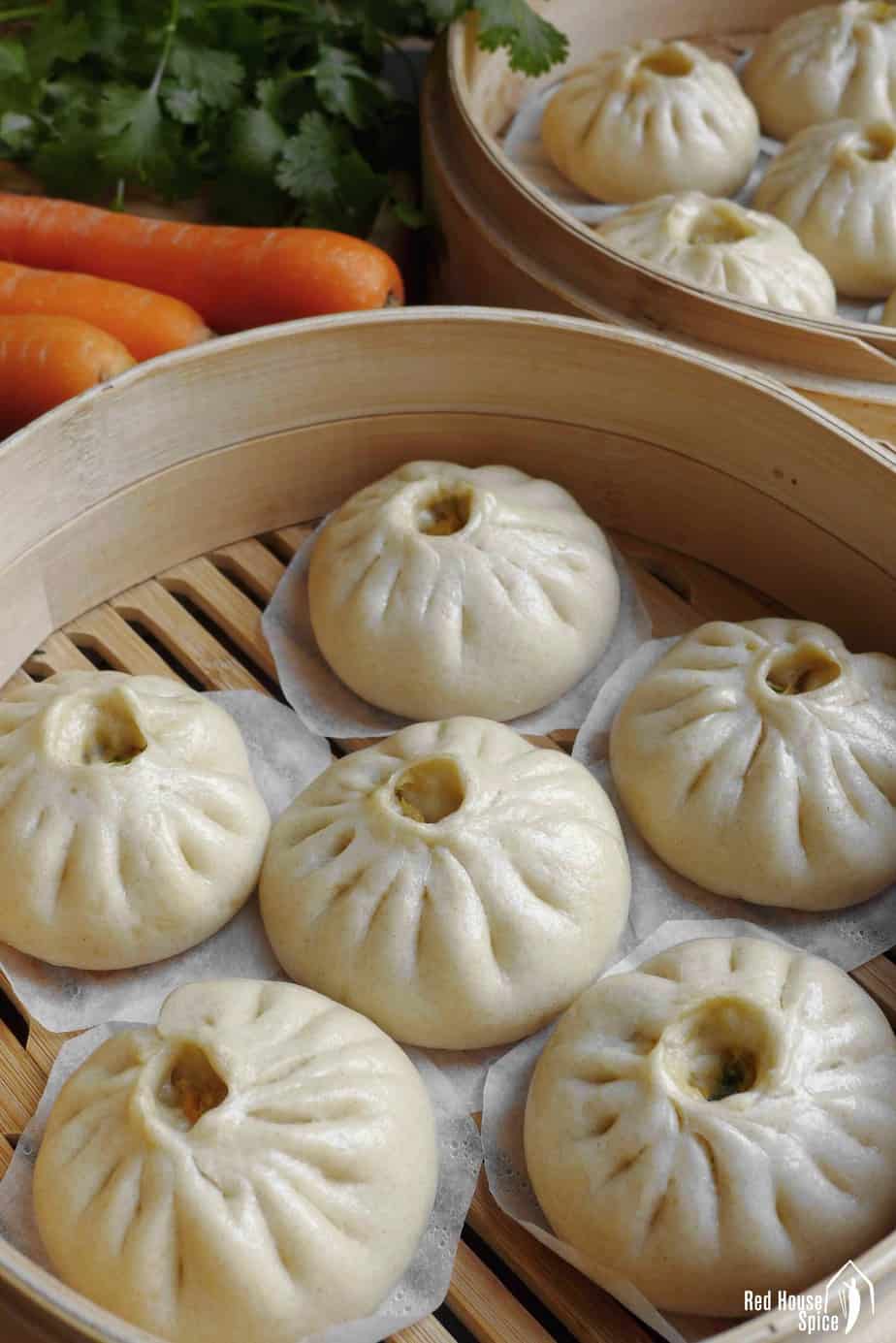
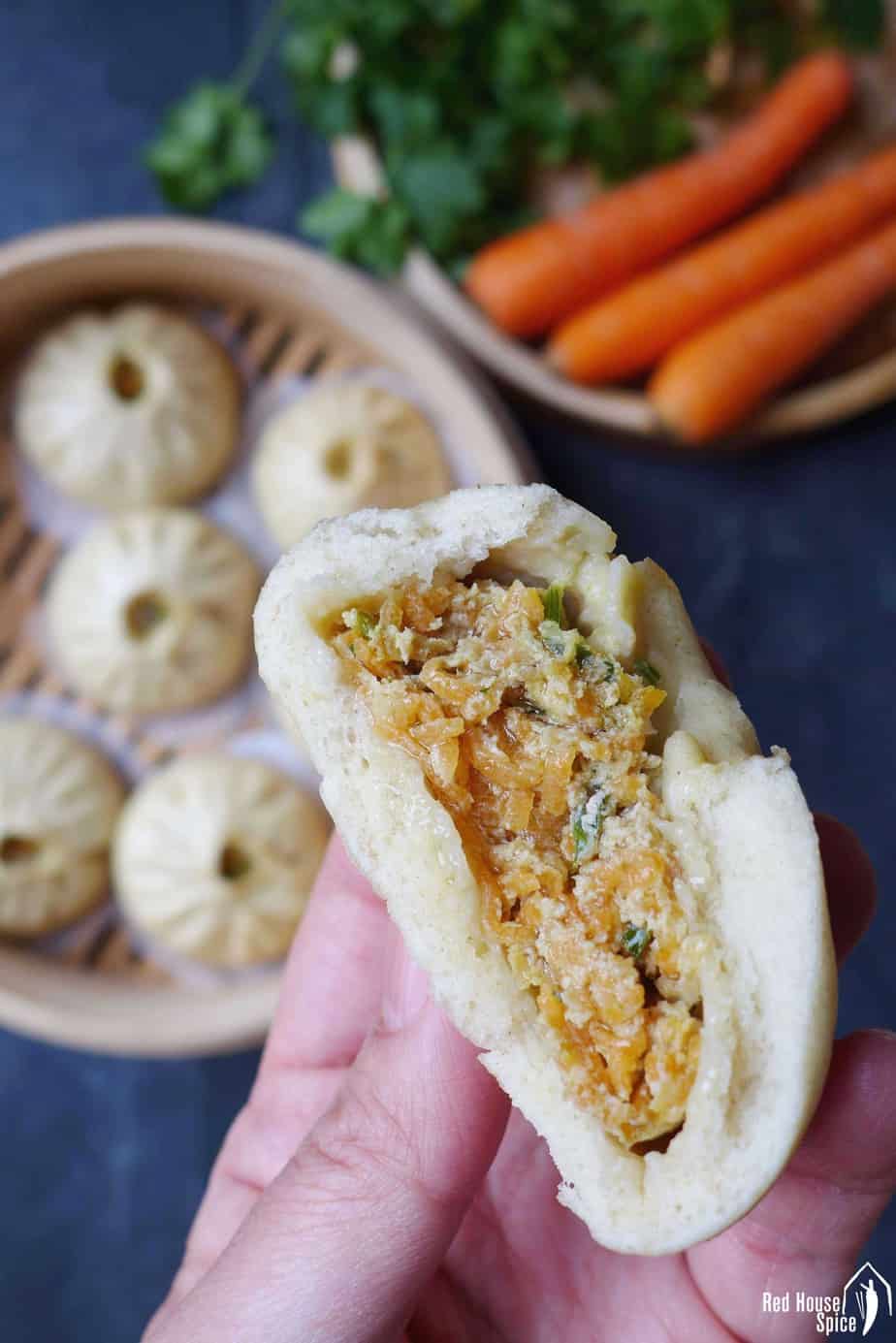
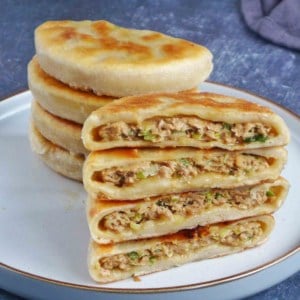
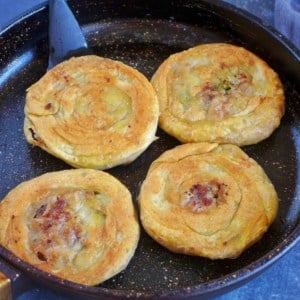
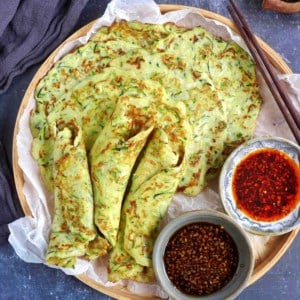
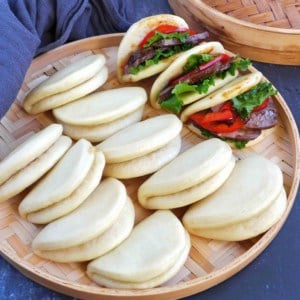
Hi, thank you so much for your recipe. When I made these today, they tasted perfect but the surface of the bao zi was all wrinkly! I used a metal double tier steamer with reusable cheese cloth on the bottom of each pan, steamed for 15 minutes and turned off the heat, left them in for 5 minutes, and then took them out. What went wrong? Do you have any advice? Thanks in advance!
Thank you, Anna, for trying out my recipe! I’m not sure if you have read the entire blog post which includes a section on “HOW TO AVOID BAO BUN COLLAPSING”. This part will help you to troubleshoot the wrinkly issue.
I made some again with leftover dumpling filling from yesterday (happy new year!) and this time I paid more attention to each of the points you made in that section. I think the big one was starting the bao zi over the water (last time I tried to save time by heating the water during the second rise). They turned out so much better! Not as pretty as my mom’s but closer. Thank you again
hello this is Alex from Greece,
Thank you for all your recipes, everything I have tried so far has turned out great! just a quick question, can I make bad buns ahead of time and keep them in the fridge before steaming them and if yes how long can I store them I the fridge? does the same apply for spring rolls and dumplings too?
It isn’t ideal to freeze uncooked bao buns as their leavened dough doesn’t behave properly after freezing. However, cooked bao buns can be frozen and reheated in the steamer before serving. They will be as nice as fresh ones.
Regarding spring rolls and dumplings, they can be frozen uncooked. You can find precise instructions in my recipes.
I was a bit skeptical to try and make bao, mainly because I’m very new to bread making, however, these have turned out great! I followed the recipe exactly and the dumplings are so delicious. I’m so surprised with how easy they are to make! If you’re a bit unsure, just do it! They are so worth it!
Thank you for a great recipe, I’ll definitely make these again!
Very happy to hear that Cassandra! Yes, they’re easier to make than you’d imagined.
Hey what an awesome recipe, I was short on flour when I made them and didn’t compensate for it with less water, miraculously enough it worked out perfectly, they’re light and fluffy, steamed them in a rice cooker and I was unsure of the actual cooking time but the dough seems pretty forgiving on that end as well.
It’s a mainstay since I’m a frozen supermarket bao fiend
So happy to hear you enjoyed these buns!
Hello!
I love eating bao, but was scared to make them myself, as I’m not very good with yeast pastries.
Turned out wonderful and tiny dough pieces can hold really A LOT of stuffing (I used seasoned beef and vegetables as it’s what I had).
Also cooked 16 (recipe adjust really good too!)
Thank you very much, I’m inspired now to look into other recipes:)
They aren’t that difficult to make, right? So happy you enjoyed the recipe!
Thank you very much for your detailed recipe. After pleating my buns, they opened up no matter how tight I pinched it. May I know what went wrong? Thanking you in advance!!
I suspect that the rim of your wrappers were wet by the filling. If this is the case, it’s quite difficult to seal no matter how much you pinch it. So I suggest you use a little less filling and be careful not to wet the rim of the wrappers. If they get wet, dust with a little flour to dry it. Hope this helps!
Hello, thank you for sharing your tips for making bao buns. 8 have Ben putting this 9ff ff8r months!! I haven’t made yours as I’m vegan and I also want to bake mine. Do you have any tips? Is the recipe different if im not steamimg?!
Than you 👍
For vegan fillings, you can use the recipe for Vegan Dumplings or the ones introduced in my blog post on Dumpling Fillings. For baking, please follow the method in my recipe for Baked Bao Buns.
Hi Wei! For your recipe do you use instant yeast or active dry yeast? Does it matter? Could I use either or?
Thank you!!
I use instant yeast which can be mixed directly with flour. If using active dry yeast, mix it with sugar and lukewarm water and leave to sit for 5 minutes before mixing with flour.
I’ve seen some recipes use milk instead of water. (And sometimes, dried milk powder.) Is water better and why do you think. Thanks.
Water is the most common liquid for making Chinese bao bun dough. But milk can be used as a substitute. It produces a slightly fluffier, softer texture thanks to its fat content.
I’m not new to making dumplings 🥟 but this was only my third time making steamed Bao buns- my second from this recipe. This recipe is great and the instructions were very easy and helpful. I’ve made these with natural foods for colored dough but Christmas Eve I made two batches using Superfoods colored powder to get a rich red and a green colored dough. My family was happily surprised. Granted my buns were not beautiful and elegantly folded. I’m recovering from shoulder surgery on my dominate arm. Right? It is the holiday season so I couldn’t just not cook. It is one my most favorite pastimes. Cheers.
Thanks Madonna for your positive feedback! It’s a great idea to use colored dough for festive occasions.